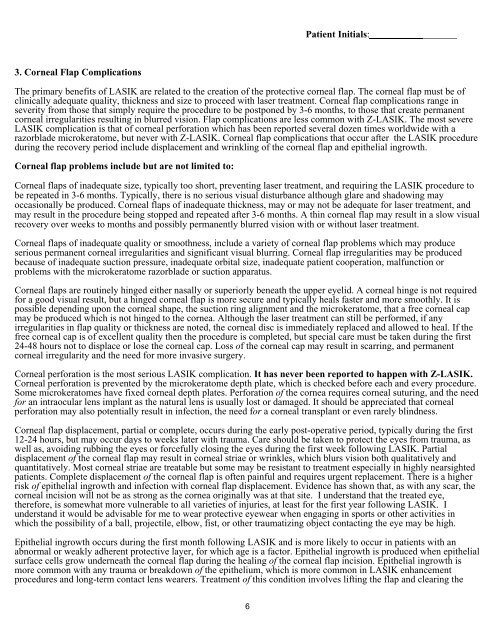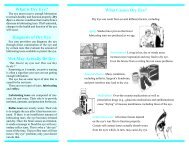lasik informed consent - initial - Braverman Eye Center
lasik informed consent - initial - Braverman Eye Center
lasik informed consent - initial - Braverman Eye Center
Create successful ePaper yourself
Turn your PDF publications into a flip-book with our unique Google optimized e-Paper software.
Patient Initials:<br />
_______<br />
3. Corneal Flap Complications<br />
The primary benefits of LASIK are related to the creation of the protective corneal flap. The corneal flap must be of<br />
clinically adequate quality, thickness and size to proceed with laser treatment. Corneal flap complications range in<br />
severity from those that simply require the procedure to be postponed by 3-6 months, to those that create permanent<br />
corneal irregularities resulting in blurred vision. Flap complications are less common with Z-LASIK. The most severe<br />
LASIK complication is that of corneal perforation which has been reported several dozen times worldwide with a<br />
razorblade microkeratome, but never with Z-LASIK. Corneal flap complications that occur after the LASIK procedure<br />
during the recovery period include displacement and wrinkling of the corneal flap and epithelial ingrowth.<br />
Corneal flap problems include but are not limited to:<br />
Corneal flaps of inadequate size, typically too short, preventing laser treatment, and requiring the LASIK procedure to<br />
be repeated in 3-6 months. Typically, there is no serious visual disturbance although glare and shadowing may<br />
occasionally be produced. Corneal flaps of inadequate thickness, may or may not be adequate for laser treatment, and<br />
may result in the procedure being stopped and repeated after 3-6 months. A thin corneal flap may result in a slow visual<br />
recovery over weeks to months and possibly permanently blurred vision with or without laser treatment.<br />
Corneal flaps of inadequate quality or smoothness, include a variety of corneal flap problems which may produce<br />
serious permanent corneal irregularities and significant visual blurring. Corneal flap irregularities may be produced<br />
because of inadequate suction pressure, inadequate orbital size, inadequate patient cooperation, malfunction or<br />
problems with the microkeratome razorblade or suction apparatus.<br />
Corneal flaps are routinely hinged either nasally or superiorly beneath the upper eyelid. A corneal hinge is not required<br />
for a good visual result, but a hinged corneal flap is more secure and typically heals faster and more smoothly. It is<br />
possible depending upon the corneal shape, the suction ring alignment and the microkeratome, that a free corneal cap<br />
may be produced which is not hinged to the cornea. Although the laser treatment can still be performed, if any<br />
irregularities in flap quality or thickness are noted, the corneal disc is immediately replaced and allowed to heal. If the<br />
free corneal cap is of excellent quality then the procedure is completed, but special care must be taken during the first<br />
24-48 hours not to displace or lose the corneal cap. Loss of the corneal cap may result in scarring, and permanent<br />
corneal irregularity and the need for more invasive surgery.<br />
Corneal perforation is the most serious LASIK complication. It has never been reported to happen with Z-LASIK.<br />
Corneal perforation is prevented by the microkeratome depth plate, which is checked before each and every procedure.<br />
Some microkeratomes have fixed corneal depth plates. Perforation of the cornea requires corneal suturing, and the need<br />
for an intraocular lens implant as the natural lens is usually lost or damaged. It should be appreciated that corneal<br />
perforation may also potentially result in infection, the need for a corneal transplant or even rarely blindness.<br />
Corneal flap displacement, partial or complete, occurs during the early post-operative period, typically during the first<br />
12-24 hours, but may occur days to weeks later with trauma. Care should be taken to protect the eyes from trauma, as<br />
well as, avoiding rubbing the eyes or forcefully closing the eyes during the first week following LASIK. Partial<br />
displacement of the corneal flap may result in corneal striae or wrinkles, which blurs vision both qualitatively and<br />
quantitatively. Most corneal striae are treatable but some may be resistant to treatment especially in highly nearsighted<br />
patients. Complete displacement of the corneal flap is often painful and requires urgent replacement. There is a higher<br />
risk of epithelial ingrowth and infection with corneal flap displacement. Evidence has shown that, as with any scar, the<br />
corneal incision will not be as strong as the cornea originally was at that site. I understand that the treated eye,<br />
therefore, is somewhat more vulnerable to all varieties of injuries, at least for the first year following LASIK. I<br />
understand it would be advisable for me to wear protective eyewear when engaging in sports or other activities in<br />
which the possibility of a ball, projectile, elbow, fist, or other traumatizing object contacting the eye may be high.<br />
Epithelial ingrowth occurs during the first month following LASIK and is more likely to occur in patients with an<br />
abnormal or weakly adherent protective layer, for which age is a factor. Epithelial ingrowth is produced when epithelial<br />
surface cells grow underneath the corneal flap during the healing of the corneal flap incision. Epithelial ingrowth is<br />
more common with any trauma or breakdown of the epithelium, which is more common in LASIK enhancement<br />
procedures and long-term contact lens wearers. Treatment of this condition involves lifting the flap and clearing the<br />
6






